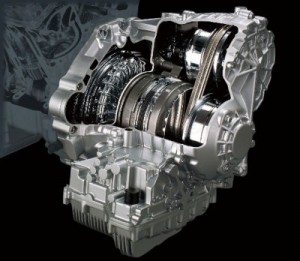The “new kid” of automatic transmissions is called the Continuously Variable Transmission (CVT) and though the technology actually dates back over 60 decades, these transmissions now appear on their way to entering the mainstream.

Transaxles-Front Wheel Drive and CVT Transmissions
Continuously Variable Transmissions are said to offer the efficiency and economy of a manual transmission with the convenience of an automatic, supposedly promising the best of both worlds.
(CVT’s) offer a lighter and more compact design than conventional automatic transmissions, they’re also as fast as a manual in acceleration while being smoother and more economical than an automatic.
While that may sound almost like a “cake and eat it” proposition, CVT’s will not solve all automatic transmissions oddities. One of the reasons they haven’t fully caught on – yet – is that their practicality has until recently been limited mostly to smaller cars with transverse-mounted engines and front wheel drive transmission setups.
Subaru Transmissions pioneered the modern production CVT with an ECVT (electronic CVT) on the 1989-93 Subaru Justy but, according to Subaru, they stopped selling ECVT because the Justy was an on-demand 4WD and they wanted to concentrate on full time all wheel drive vehicles. Reliability issues and high maintenance costs for the old ECVT, were a problem at the time, not as much with the new technology being reinvested.
While CVT’s are currently featured on some small economy cars such as the gas/electric hybrid Honda Civic and Toyota Prius, the transmission is also beginning to appear on more mainstream vehicles such as Audi’s mid-size higher end performance A4 and A6 models. And more are coming.
Unlike the “conventional” transmissions’ fixed set of gears, torque converters, and/or other components, a CVT uses a relatively simple belt and pulley design. The belts can slide up and down from narrow to wide end of the cone-shaped pulley which allows for supposedly infinite “continuously variable” ratios.
The more gear ratios offered, the more the vehicle’s engine can operate at its ideal RPM range (revolutions per minute) and load – so when you hit the gas to peel out from a red light, the engine will stay closer to its horsepower peak for maximum power. However, with conventional transmissions only offering up to six distinct gear ratios, you’re constantly passing through that peak point and have to up-shift to recapture it.
With a CVT, the “gear ratios” can be varied instead of the engine RPM’s. This means that, for example, an engine with peak horsepower and torque at 4000 RPM can be kept at that level much more easily than a conventional transmission that must be shifted – manually or automatically – to keep the engine in the “power band.”
As the technology improves and as the CVTransmission continues to make it’s way into the main market of car transmissions, I expect to see more cars with this transmission technology. You can count on GotTransmissions.com to stay on top of the latest happenings in transmission news. For all of your transmission replacement needs, Call us @ 1-877-268-0884.


